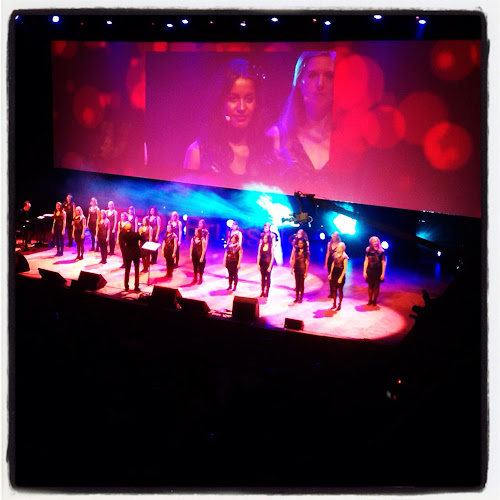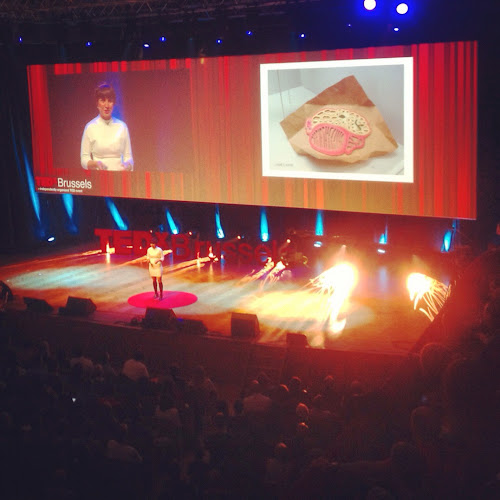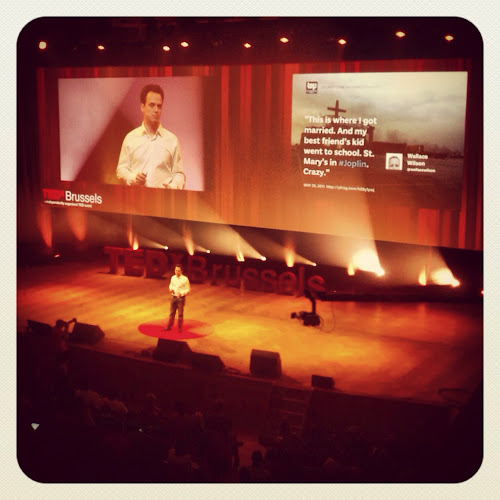Today I am joined by 2200 other TEDx followers. TEDx is an independent TED organization. Today we are together in one of the nicest venues in Belgium: BOZAR. Entering the room already gives you the energy you expect from a day like this. For the first time ever I’ll try to live blog the event. Let’s see how that turns out to work.
9:10 – Opening Choir: Brothers Kolacny and their 23 SCALA girls think we are “Fucking Special”. Very sober version of Creep by Radiohead.
9:20 – Steve Wozniak: when kids go to school for the first time they are told that they can only learn what they are supposed to learn. Yet another great mind talking about the failure of our old-school educational system. The little boys/girls that can use technology as young as possible could be the innovato of tomorrow. The inhibitors of inovation are the big businesses and will assimilate the ones that would disrupt their big money machine. We need more of those little “builders”! Did you know the Apple I and Apple II were completely ‘open’? ‘Visical’ was probably the first app that made Apple bigger because the Commodores and others could not expand for that workload. 20 years later the same happened by opening iTunes/iPod for Windows.
9:40 – Alan Greene: – Pediatrition – How can we transform the lives of children over the world? WHO (World Health aprganization) found that 29% of new born deaths are by now getting enough OXYGEN in their first minutes of life. So how do we get these children to get kore Oxygen in that room? Oxygen cans? too expensive. A second issue is that we have not enough IRON. Iron deficiency loses intelligence. Health and economic benefit would be oveqr 20% if we didn’t have iron deficiency in the 3rd world. But this also is really hard to do and extremely expensive. the solution: at the moment a baby is born, a 3rd of their blood is still outside of their body. Leaving the “abiligan cord” on for an extra 90 seconds would give the children that extra oxygen and iron from their mothers blood! TicTalk campaign: changing the abilical cord clamping from “imidiate” to “optimal”.
10:00 – Mitch Altman: #Wednesday. TV-b-gone. Big supporter of creating communities to create like HackerSpaces. what is a HackerSpace? it is a physical place where hackers can work/play together. Start by hacking yourself: learning and growing. Taking what is and sharing what you find. How about inventing a keychain that disables tv’s? This was just a start. In the beginning a HackerSpace was only on conferences, after that it became more spread and now here are over 175 HackerSpaces around the world.
10:20 – Alexander Asseily: cultural explosions. Alexander talking about the power of drawings to explode culture. The Phonetinas gave us symbols – the phonetic alphabet – that helped us communicate. at that point in time those symbols were just abstractions of something real: “A” could have been the head of a bull wth horns upside down. The next big evolution was thousands of years later by Guthenberg: the distribution of word by printing multiple times. Radio and Electronic communication might have been the 3rd big explosion. Not only by distribution but more importantly about the access.
10:40 – Andrew Keen (@ajkeen): BANG BANG! Comes to talk about the future crime; The Digital Vertigo! What do you see when you look to the one in the chair next to you? Class, religion, food preferation, … ? No, we see mysteries, secrets and questions. But more and more we just become data. We will see what people are about without knowing the real people behind it. Think about google glass, highlight, banjo, … we are living the Truman Show. We need to learn to escape!
11:00 – First break: I am not blown away. Off course I truly respect the engineer within Steven Wozniak and the anarchism Mitch Altman breathes but the only one that touched me this first serie of sessions was Alan Greene. He showed us how a really small change in birth procedure could change the lives of so many people and in the end even benefit economy. This was an inspiring TED talk as I like them. Andrew Keen gave a really vibrant talk about closing up instead of opening everything to everyone. I respect his vision but as you know me by now, I don’t really share his ideas.
11:40 – Zoe Laughlin (@ZoeLaughlin) : what are materials? Even the periodic table of elements is just a grouping of things that make materials. But are they? Even a copper spoon or a copper fork are different although they both share “copperness”. is a ‘crystal’ the point of difference? Zoe shows us a single metal crystal of over 30cm that is used to make jet-engines. By the way, did you know Zoe has a moustache … if you look closer wth a microscope 🙂 To see how vibrant she can be, look at this last part of her talk:
12:05 – Monte Stettin (link): presenting wth the iPad. #winning! Digital imaging can be far more powerful than simple text. But how to educate billions of children affordably? Monte showed us a lot of examples of the nice educational videos they are making but I do miss the part of how he is going to be disruptive and inovating. we already have some apps like his. Move it on Monte and go that one step further and change the world!
12:15 – Dale Stephens: really really really didn’t like school! Decided not to go to 6th grade … waaw! Left school to take charge of his own education. Volunteered in the community, worked at some startups in Silicon Valley. So he learned tons of things he couldn’t learn in school and lots more. But besides the “hacking your education” life he had, it appeared that being gay had similar challenges. Who are the Velvet Maffia? The ones that are looking for benefits behind being gay? So Is there an advantage to being a misfit? And is that positive? If you embrace the fact of being vulnerable, you have a responsibility of being visible! Misfits are the X-Men of tomorrow.
12:30 – Eri Gentry (@erigentry): find your meaning in live and make somethng of it! We are only 10% human, the rest is microbes 🙂 but if you see that unseen, it’s your doorway to discovery. Have a look at “DYIBIO”, a group that started meeting each other weekly just talking about doing cheap research. The HackSpaces of Science. The community labs started to emerge. Eri could grow her company ‘bio curious’ from cheap to great in less than 2 years. Lots of crazy ideas could become big this way. It’s not the PHDs that will change the world, it’ll be the creatives that can grow themselves from the spare bedroom laboratories.
12:45 – Greg Gage (@gagegreg): I am a neuroscientist and spend 6 years in graduate school to learn how the brain works. That in such was already a shame that I had to go to grad school to get that information. So I decided to change that and did workshops in lower schools. but how to take $400.000 lab to a school? So they made “backyard brains“, a small company that made a very small device that you can plug to your mobile phone and see what the brain really does. As a demo Greg knocks out a cockroach (puts it in ice water to sleep). After that he cuts one of its legs and put pins in that leg. These pins give us the opportunity to monitor the spikes that the neurons in that leg send to the central brain. And by giving vibrations back to the leg, it starts moving so we saw a cut off cockroach leg dancing to some beats. In the end he showed us the next part of the story: the “Cockroach Controller” a device so small that he can put on the back of a cockroach and control it’s movements with a remote (aka smartphone).
13:10 – LUNCH: this series of talks was way more inspiring. You really feel that these are people that grew something from nothing, that try to change the world from their home office, think out of the box, disrupt the status quo in their own way.
Connie Hedegard – moved to afternoon sessions
14:10 – Bruno Zamborlin (PHD in Art and Computer Science – homepage): can technology help us understand things in the physical world? Everything you touch, makes sound, vibrates. What if we could extend its capabilities? Using the vibrations of a type of touch to do something woth these vibrations. Don’t understand? Knocking on a teacup sounds diffent than tapping on it wth a spoon. Use the first sound to switch on/off the television and the second one to switch channels. And look at what happens if you hooks “objects” to a mini microphone that is connected to a cell phone:
14:20 – Aaron Rowe: every so often a shiney new technology comes along and big businesses want to grow on that. Urinal analysis strips are something like that. these strips can give for example pregnant women on a regular base if she has enough proteins etc. How about elderly in a home that get a box as-cheap-as-possible tests that show them the basics health of their liver. We made an app that can scan you tests and based on some of your metadata (age, gedner, …) give you a better insight in your acurate health. How about upgrading those blood sugar meters and let them check more than suger only, hooked up to that app?
14:30 – Dr Stuart Firestein: it’s very difficult to find a black cat in a dark room … specifically if there is no cat. Scientific method versus farting around. “thoroughly conscious ignorance” (James Clerk Maxwell). Knowledge is big, ignorance could be bigger! Science is not a puzzle: a puzzle has been made and by design has an end. Science should always be wrong, it solves a problem by creating 10 more. So what we do with knowledge should give us stronger ignorance instead of the other way around.
14:50 – Tito Jankowski: co founder of Bio Curious and Scanadu, 2 companies we have already seen in the talks of Eri Gentry and Aaron Rowe. Didn’t like this guy. Cheap sales talk from a guy that thinks he is Rock and Roll, wearing a Rolling Stones shirt and some John Lennon sunglasses on stage. this guy makes you think he bought this session (and maybe the 2 others too).
15:05 – Irene Van Peer: Product designer building ‘stuff”. Can technology play a role between pigs and humans? “Pigs Chase” is a game between a human on an iPad and a pig with a huge touchscreen. You’ll have to google this to see it. Very inspirational. For now it’s only a concept video but the idea is awesome. Trying all different types of interchanging with these pigs really gave the scientists a lot of insights in pigs.
15:20 – Yasaman Sheri: as an industrial designer she thinks about the past, current and future of how specific objects are designed. There is a world beyond the physical what i called the digital. You can take a few pictures of yourself, load them through Autodesk and have it create a 3D model of yourself that could be 3D printed later by a webshop. The next generation of object designing will be about biological engineering.
Nice quote: “Whenever you feel sad, just remember the are billions of cells in you body and the only thing they care about is you”
15:30 – Peter Jansen: the fun of figuring things out. How if I could really invent the stuff in Star Trek? Take a “Tricorder”. So I did. It can see atmospheric details, electromagnetic, temperatures, magnetism, … And at a certain point in the designing process you feel the urge to share the knowledge you gained. So I made it an open source project. The morning after over 25.000 people had visited the website.
15:45 – Yvonne Cagle: former NASA astronaut. What made her wanting to go in space? And why doesn’t everyone wants to go in space? This talk was more of a poetry session than a real inspirational TED talk to me. It seemed she still was somewhere in space. Would they have drugs for that at NASA? 🙂
Just before the break we get an Australian student that won a prize with his PHD, Peter V Liddicoat. He made a super-alloy in aluminium.
16:05 – BREAK
MADE IN BELGIUM
17:00 – Jeroen Raes (@jeroenraes): people have 1,000,000,000,000,000 bacteries on your body. You are not human, you just a bunch af bacteria. But what if you start studying the gut microbiome wth metagenomics? They found 3 “entrotypes” like types of forest. These are groups that live together in a specific type of environment. This is the reason disturbance to your gut flora can give you diseases, diarhea, … even obesitas can be caused by the disturbance of your gut flora. So don’t mess wth babies flora. It can have a life-long consequenses. Some people can never recover by changing a diet because it could even disturb the body even more. Gut flora even influences behaviour and intellect.
17:15 – Ben Kestner (@KestnerTweet): breaking down the walls between schools and communities. If students can google the answer, we are asking the wrong questions. WAAW! amazing quote here. We are teaching to the test, not to the interest of the children. A school with no homework and no grades where you can learn what you want is more crazy than hoping on getting superpowers by eating an apple. Some of these schools are rising in the States. No tests, no grades and only mentors instead of teachers with a max of 15 pupils each. More than 98% of these kids get college acceptence. Think about that …
17:30 – Rudi Pauwels: having a healthier life is what we wish for each year again. But how do we succeed in increasing life expectance? All that progress comes out of cost. And this will only grow. By 2040 we ar going to spend over 25% of our GDP to health care. Can we change that? Why spend billions of dollars on medicines that do not work for everyone? What if we could find a single moucule that tells us what disease you wpuld get? The future of health will be around focussing on acurate and more personal health care. Only then we will be ready to create “moleculair medicines”.
17:45 – Alexander D’Hooghe: talking about “Universal Building”. We started moving to the suburbs because they were green over 20 years ago. The result of that is that we attracted the supply chain industry to those suburbs. So we don’t have green there either. How can we bound these thing together? People like nature, but we also like living in the community and a last thing we really like is progress. Combining at least two of these with each other in building projects. The killer could be having all 3. But what happens when you add all colors to each other? You get WHITE. Whatever you add to the white, it will get more towards one of the choices. So making white squares that can be filled in the moment and changed afterwards could be one of the nicest things you could design for everyone.
18:05 – Xavier Damman (@XDamman) CEO of Storify: regular people wth smartphones are the real reporters of today. Think about the guy that tweeted about helicopts in Afghanistan the night Osama Bin Laden was killed. WE ARE THE MEDIA! Speak up and let the world know.
At the very end I can close this extraordinary day wth Xavier Damman showing the room our own power:
18:30 – CLOSING DRINKS




